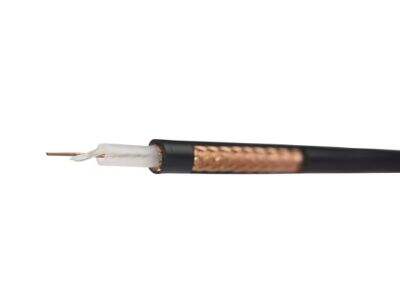RG8 e LSR400 sono due tipi di cavi che si sentono spesso menzionare quando si tratta di inviare segnali da un punto A a un punto B tramite un cavo. Ogni cavo ha il proprio utilizzo e limitazioni. In questa guida GF dimostreremo le differenze tra i cavi RG8 e LSR400. E ci assicureremo di aiutarti a decidere quale dei due soddisferà perfettamente le tue esigenze.
RG8 vs cavo LSR400
Sebbene i cavi RG8 e LSR400 vengano utilizzati per trasferire segnali, essi differiscono nei loro componenti. Un cavo coaxiale è progettato specificamente per trasportare segnali, e quindi è possibile che RG8 sia coaxiale. Il cavo è ideale per segnali come quelli radio e ha un'impedenza di 50 ohm. Il cavo deve avere quest'impedenza per funzionare correttamente con altri apparecchi.
D'altra parte, l'LSR400 è anch'esso un cavo coaxiale ma progettato per perdere meno durante la trasmissione del segnale. Come rg8x coax , LSR400 è anche di 50 ohm, ma progettato per applicazioni ad alta frequenza. Ciò consente di inviare segnali molto rapidi e per farlo è necessario un connessione solida.
Per quale cavo RG8 o LSR400
Il cavo RG8 è preferito da numerosi operatori radio amatoriali e appassionati dilettanti in quanto è flessibile e si installa facilmente a costi inferiori rispetto ad altre alternative. È facile trovare in vendita il cavo RG8 nei negozi e online, grazie alla sua idoneità per un numero elevato di diversi compiti, il che significa che puoi utilizzare lo stesso prodotto in una vasta gamma di scenari. RG8 è inoltre resistente e può sopportare condizioni meteorologiche rigide come pioggia, vento e temperature estreme. È incredibilmente robusto, il che lo rende un materiale perfetto per applicazioni all'aperto.
Il cavo LSR400, d'altra parte, è preferibile quando si deve trasmettere segnali a lunghe distanze senza perdere troppa potenza. Questo è un cavo di lunghezza considerevole con un basso tasso di attenuazione, e quindi il segnale può normalmente arrivare quasi ovunque si desideri. A sua volta, ciò può rendere l'LSR400 una scelta migliore per applicazioni ad alta frequenza in cui mantenere un segnale forte è critico, come nelle comunicazioni microonde e nella radiodiffusione satellitare.
Come decidere tra il cavo RG8 e LSR400
Ecco alcune delle cose essenziali da considerare quando si sceglie tra i cavi RG8 e LSR400. Per esempio, se hai bisogno di un cavo versatile che possa svolgere molte funzioni diverse e fare il lavoro in molte situazioni diverse, il RG8 cavo coassiale potrebbe essere la soluzione migliore per le tue esigenze. È progettato anche per l'uso all'aperto, quindi è resistente alle intemperie. In generale, questo è ciò che rende il RG8 il cavo perfetto per una vasta gamma di progetti.
Se, d'altra parte, devi inviare segnali a distanze molto lunghe con una perdita di segnale trascurabile, allora LSR400 è preferibile. Ottimizzato per alta frequenza, dove non puoi permetterti il calo del segnale. Considera la posizione e l'uso previsto del cavo prima di decidere quale acquistare.
Cavo Costante o Variabile?
Ora, quando si tratta di scegliere tra cavi RG8 e LSR400, devi pensare a che tipo di servizio li utilizzerai. Se stai lavorando con frequenze radio o trasmissioni televisive, allora RG8 si adatta correttamente. È in acciaio, Cavo robusto, ma comunque flessibile, abbastanza da funzionare in la maggior parte degli ambienti e situazioni.
Se stai lavorando con compiti ad alta frequenza come comunicazione microonde o operazioni satellitari, allora LSR400 probabilmente si adatterà meglio. Con un basso tasso di attenuazione, il segnale in entrata può rimanere relativamente forte anche dopo aver percorso lunghe distanze - rendendolo perfetto per queste applicazioni.
In risposta, i cavi RG8 e LSR400 precedenti sono cavi coassiali di tipo segnale, ma hanno specifiche diverse che li rendono ideali per un compito specifico. A causa della sua flessibilità e resistenza, il RG8 è adatto per applicazioni che utilizzano basse frequenze, il che lo rende un cavo coassiale accettabile per varie applicazioni. Tuttavia, l'LSR400 è specifico per alte frequenze, quindi offre una maggiore conservazione del segnale a distanza. Quando si sceglie tra questi due, si deve anche tenere conto delle proprie esigenze specifiche in modo da poter trovare il miglior cavo per il proprio progetto o applicazione.
 IT
IT
 EN
EN AR
AR
 BG
BG
 HR
HR
 CS
CS
 DA
DA
 NL
NL
 FI
FI
 FR
FR
 DE
DE
 EL
EL
 JA
JA
 KO
KO
 NO
NO
 PL
PL
 PT
PT
 RO
RO
 RU
RU
 ES
ES
 SV
SV
 TL
TL
 ID
ID
 LT
LT
 SR
SR
 SK
SK
 SL
SL
 UK
UK
 VI
VI
 HU
HU
 TH
TH
 TR
TR
 AF
AF
 GA
GA
 BE
BE
 LA
LA
 MN
MN
 SU
SU
 UZ
UZ
 XH
XH




